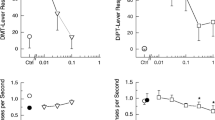Abstract
The effect of the selective 5-HT3 receptor antagonists ICS 205-930 and MDL 72222 on head shaking behavior induced by l-5-HTP and behavioral symptoms induced with 5-methoxy-N,N,-dimethyltryptamine (5-MeODMT) in rats was evaluated. Both drugs dose-dependently reduced l-5-HTP-induced head shaking but were at least 600 times less potent than pirenperone and ketanserin and at least 50 times less potent than methysergide. ICS 205-930 and MDL 72222 were more than 1000 times less potent than pirenperone or methysergide and 100 times less potent than ketanserin in blocking 5-MeODMT-induced forepaw treading and tremor. Since it appears that head shakes induced by l-5-HTP are mediated by 5-HT2 receptors, these data suggest that ICS 205-930 and MDL 72222 do not significantly interact with 5-HT2 receptors in the brain. Furthermore, the data suggest that ICS 205-930 and MDL 72222 lack appreciable antagonistic activity at the 5-HT receptor(s) mediating those behavioral effects induced by 5-MeODMT.
Similar content being viewed by others
References
Aghajanian GK (1981) The modulatory role of serotonin at multiple receptors in brain. In: Jacobs BL, Gelperin A (eds) Serotonin neurotransmission and behavior. MIT Press, Cambridge, MA, pp 156–185
Bedard P, Pycock CJ (1977) “Wet dog” shake behavior in the rat: A possible quantitative model of central 5-hydroxytryptamine activity. Neuropharmacology 16:663–670
Bradley PB, Engel G, Feniuk W, Fozard JR, Humphrey PBA, Middlemiss DN, Mylecharane EJ, Richardson BP, Saxena PR (1986) Proposals for the classification and nomenclature of functional receptors for 5-hydroxytryptamine. Neuropharmacology 25:563–576
Colpaert FC, Janssen PAJ (1983) The head twitch response to intraperitoneal injection of 5-hydroxytryptophan in the rat: Antagonistic effects of purported 5-hydroxytryptamine antagonists and of pirenperone, an LSD antagonist. Neuropharmacology 22:993–1000
Colpaert FC, Meert TF, Niemegeers CJE, Janssen PJ (1985) Behavioral and 5-HT antagonist effects of ritanserin: A pure and selective antagonist of LSD discrimination in rat. Psychopharmacology 86:45–54
Corne SJ, Pickering RW, Warner BT (1963) A method for assessing the effects of drugs on the central actions of 5-hydroxytryptamine. Br J Pharmacol 20:106–120
Fozard JR (1984) MDL 72222, a potent and highly selective antagonist at neuronal 5-hydroxytryptamine receptors. Naunyn-Schmiedeberg's Arch Pharmacol 326:36–44
Green AR (1984) 5-HT-mediated behavior. Neuropharmacology 23:1521–1528
Jacobs BL (1976) An animal behavioral model for studying central serotonergic synapses. Life Sci 19:777–786
Janssen PAJ (1982) The pharmacology of specific, pure and potent serotonin 5-HT2 or S2-antagonists. In: Yoshida H, Hagihara Y, Ebashi S (eds) Advances in pharmacology and therapeutics, II. Biochemical immunological pharmacology. Pergamon, Oxford, pp 21–35
Leysen JE, Awouters F, Kennis L, Laudron PM, Vandenberk I, Janssen PAJ (1981) Receptor binding profile of R 41, 468, a novel antagonist at 5-HT2 receptors. Life Sci 28:1015–1022
Leysen JE, Niemegeers CJE, van Neuten JM, Laudron PM (1982) (3H) Ketanserin (R-41468), a selective 3H-ligand for serotonin2 receptor binding sites. Mol Pharmacol 21:301–314
Lucki I, Nobler MS, Frazer A (1984) Differential actions of serotonin antagonists in two behavioral models of serotonin receptor activation in the rat. J Pharmacol Exp Ther 228:133–139
Matthews WD, Smith CD (1980) Pharmacological profile of a model for central serotonin receptor activation. Life Sci 26:1397–1403
Nelson OL, Pedigo NW, Yamamura HI (1980) Multiple types of serotonin receptors. In: Yamamura HI, Olsen RW, Usdin E (eds) Psychopharmacology and biochemistry of neurotransmitter receptors. Elsevier, North Holland, Amsterdam, pp 325–338
Niemegeers CJE, Colpaert FC, Leysen JE, Awouters F, Janssen PAJ (1983) Mescaline-induced head-twitches in the rat: An invivo method to evaluate serotonin S2 antagonists. Drug Dev Res 3:123–135
Peroutka SJ, Snyder SH (1983) Multiple serotonin receptors and their physiological significance. Fed Proc 42:213–217
Peroutka SJ, Lebovitz RM, Snyder SH (1981) Two distinct central serotonin receptors with different physiological functions. Science 212:827–829
Richardson BP, Engel G, Donatsch P, Stadler PA (1985) Identification of serotonin M-receptor subtypes and their specific blockade by a new class of drugs. Nature 316:126–131
Sloviter RS, Drust EG, Connor JO (1978) Specificity of a rat behavioral model for serotonin receptor activation. J Pharmacol Exp Ther 206:339–347
Smith LM, Peroutka S (1986) Differential effects of 5-hydroxytryptamine selective drugs on the 5-HT behavioral syndrome. Pharmacol Biochem Behav 24:1513–1519
Tricklebank MD, Forler C, Middlemiss DN, Fozard JR (1985) Subtypes of the 5-HT receptor mediating the behavioral responses to 5-methoxy-N,N,-dimethyltryptamine in the rat. Eur J Pharmacol 117:15–24
Yap CY, Taylor DA (1983) Involvement of 5-HT2 receptors in the wet-dog shake behavior induced by 5-hydroxytryptophan in the rat. Neuropharmacology 22:801–804
Author information
Authors and Affiliations
Rights and permissions
About this article
Cite this article
Shearman, G.T., Tolcsvai, L. Effect of the selective 5-HT3 receptor antagonists ICS 205-930 and MDL 72222 on 5-HTP-induced head shaking and behavioral symptoms induced by 5-methoxy-N,N,dimethyltryptamine in rats: comparison with some other 5-HT receptor antagonists. Psychopharmacology 92, 520–523 (1987). https://doi.org/10.1007/BF00176488
Received:
Revised:
Issue Date:
DOI: https://doi.org/10.1007/BF00176488




